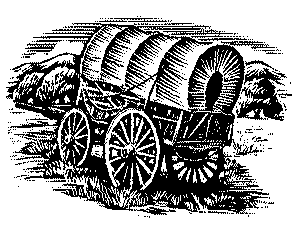|
Elko's Hot Hole on Bullion Road was one of the stops, although not the only one where the town would be built. There are several stories about wagon train animals falling into the near boiling water and dying an agonizing death. The place was once dubbed the hole "Chicken Soup Springs," not because chickens drowned and were cooked in the hot water there but from the combination of minerals that gave it a peculiar odor. Hot Hole had a reputation as a travelers stop for more than one hundred years. In this century, until the place was fenced in because it was dangerous, it was a popular resting place for those legendary knights of the rails, the people we used to call bums and hobos but today, being properly politically correct, refer to them as transients. Back to the California trail. Those dream chasing pioneer adventurers in 1850 left oftentimes established homes and farms to endure dreadful hardships to get to a totally unknown place where they thought they would find the proverbial Pot of Gold. It was a new experience for them all. How did they even know what to take on the trail? Now that's food for thought. The pun is intended. None of them had made the journey before and they were facing a four to six month trip. Were there stores available out in the wilds? Sure, there were a few trading posts scattered sporadically about but their inventory frequently had big gaps in essentials. It was best to take your full supply of everything. So, as people do today, they turned to a how-to book. In an 1850 guide book, the problem is solved. The items listed are recommendations for one person.
By now there is hardly room for anything else but a traveler purchased the following food (remember, this is for one person): Flour is a must, 130 pounds at $4, 25 pounds of cornmeal, 65 pounds of crackers, 25 pounds of rice; 80 pounds of salted ham or bacon for $7.50, 25 pounds of venison jerky (Hey! Gotta have a varied diet), 50 pounds of beans (thank goodness they were headed to wide open spaces) for $3, 35 pounds of coffee for $1.25, one pound of tea, 35 of sugar at $2.00, one gallon of pickles, and one bushel of dried fruit. They were advised to take six pounds of salt and pepper. Add the cost of outfitting (wagon, mules or oxen, clothing, etc.) to the price of food, the tally is about $400. Add three family members (food and clothing only) one might have to shell out about $600 to go on the trip. Hey, $600 doesn't sound bad until you consider that in today's cash that's about $6,000. Many of those folks mortgaged their homes and lands, used savings, or borrowed money. About the fastest time on record, probably by horseback with pack animals, was 90 days. Most of those going by wagon took one to three months more of bone bruising torture. Oxen were the most popular means of pulling the wagon. The beasts were slower but could pull heavier loads than mules and horses and provided food if they happened to die. They were also a safety factor. The Indians preferred mule or horse meat so oxen were seldom stolen or killed. A count was made at Fort Laramie in 1850 and the statistics are staggering. In that year 39,506 men passed through the fort. With them were 2,421 women and 609 children. There were 9,927 wagons, 23,172 horses, 7,548 mules, 36,116 oxen, and 7,323 cows. A family of four with over two tons of goods loaded into a wagon was ready for the trying journey to a new land of dreams. They spent around $6,000 in today's money. A hundred day trip today, staying in motels, eating at restaurants, and fuel will run an extremely conservative $10,000 but we can make the same trip in five days and add only $500 or $600 to our credit cards. Those people 150 years ago had to have intestinal fortitude to give them courage and a strong stomach for the food to stand the rigors of the journey. They had to have a strong belief in their dreams, perhaps some were even foolhardy. Many didn't make it. Shallow graves next to the unyielding trail were numerous. Bodies of young and old alike were left in the desert to be mourned by those who had to keep going. They reached for a mystic future and had no idea what fate awaited them if they got there. Whether they were planners, dreamers, or adventurers, there has to be deep respect for the pioneers who passed here on their way to who knew what. November 18, 1998
�1998 by Howard Hickson. If any portion or all of this article is used or quoted proper credit must be given to the authors. |
 Besides
buying a wagon or two for $85 apiece, add four to eight oxen at $50 each
or a few mules for $75 a head. According to the dreams the person was pursuing,
take a plow or gold washing equipment. Add guns and ammunition supplies,
a tent, shoes and nails for the livestock, clothing, bedding, and utensils.
Besides
buying a wagon or two for $85 apiece, add four to eight oxen at $50 each
or a few mules for $75 a head. According to the dreams the person was pursuing,
take a plow or gold washing equipment. Add guns and ammunition supplies,
a tent, shoes and nails for the livestock, clothing, bedding, and utensils.